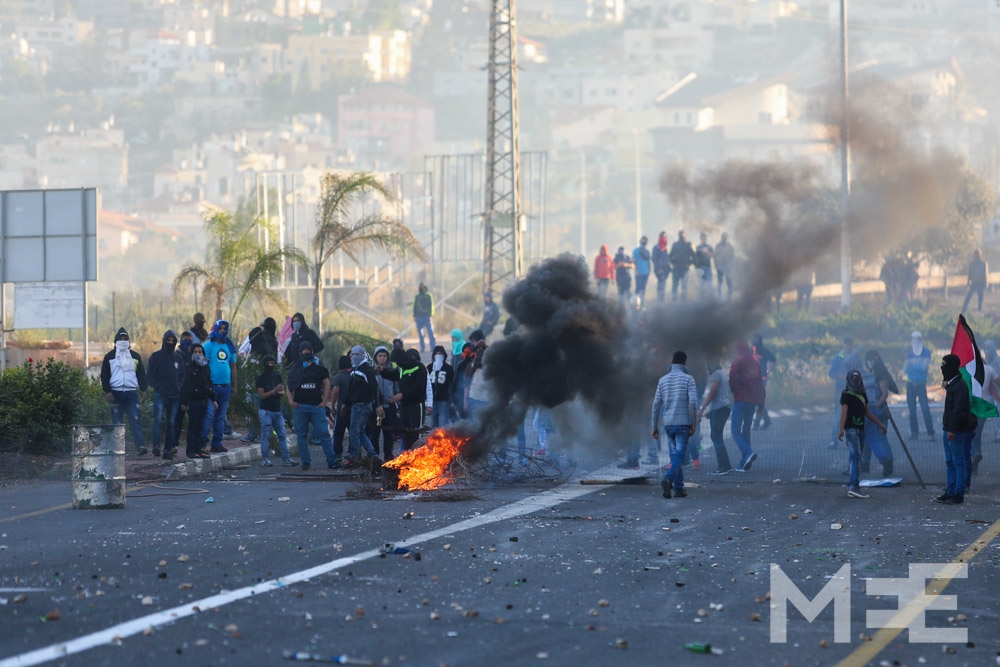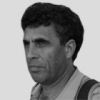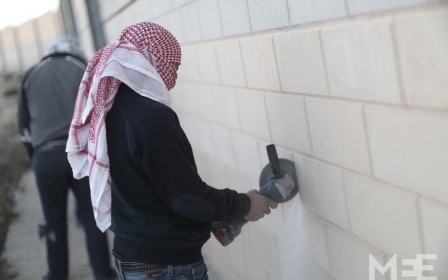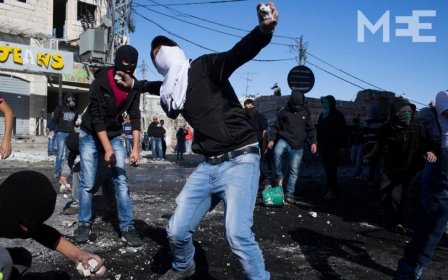From Jerusalem, with hate

On the face of it, Kheir a-Din Hamdan's death has nothing to do with al-Aqsa. This 22-year-old man lived in Kfar Kana, an Arab village in northern Israel more than 100 kilometres away from Jerusalem and he allegedly attacked a police car on patrol in the village – not because it violated the sanctity of Haram a-Sharif. Yet in the poster distributed by protestors after Hamdan was shot at close range, while running away from the police, he is portrayed with al-Aqsa Mosque on his back. The writing said: "Victim of the police and its minister's hatred. The charge: being an Arab."
The writing is a direct reference to a statement by Internal Security Minister Yitzhak Aharonovitz, who only last Wednesday praised a police officer who had shot dead a Palestinian attacker in Jerusalem, saying that "a terrorist who attacks civilians must die."
Yet while in Jerusalem a Palestinian was killed this week after he drove his car intentionally at Israeli passers-by, killing two of them, Hamdan didn't pose any real threat to the four policemen sitting in their car, according to a video clip released some hours after the incident. Aharonovitz is now being blamed for the death by encouraging the policemen in Kfar Kana to pull the trigger.
The Israeli police are not usually trigger happy. Its policemen do carry arms, but only rarely do they use their weapons, even against armed criminals, let alone innocent civilians. That is, unless you are Palestinian citizen of Israel. According to Mosawa, an organisation dealing with the human rights of the country's Palestinian minority, since October 2000, 49 Israeli civilians were killed by the police, 48 out of them were Palestinians, one was Jewish. Put it differently, Palestinians represent 20 percent of the Israeli population but 98 percent of those killed by police fire. Hamdan has now joined this gloomy statistic.
One of the bloodiest incidents in this history of police violence happened in October 2000. After seven Palestinians were killed in al-Aqsa by Israeli police following Ariel Sharon's visit to the compound a day before, widespread and at times violent demonstrations broke out in many Arab villages and towns inside Israel. The reaction of the police was harsh. Thirteen Palestinians were killed by police fire, one of them in Kfar Kana, the same village where the latest deadly incident took place.
An official judicial inquiry committee, set up following heavy political pressure from Israel's Palestinian population, severely criticised the police and its conduct, especially the unlawful and unauthorised use of sniper fire, and demanded that legal action be taken against policemen involved in the killings.
But as evidence was not collected in the first days after the shootings, this task proved impossible. All inquiries were closed and not even one indictment was filed against the perpetrators. The wounds of October 2000 have never truly healed.
For the duration of the Second Intifada, which went on till 2005, tensions between Palestinians and Jews inside Israel remained high and Palestinian citizens of Israel were often treated by police as terrorist suspects. Between 2000 to 2008, Mossawa counted more than 30 cases in which Israeli policemen killed Palestinian citizens of Israel.
In most cases, those killed were suspected of criminal actions and not of being involved in terrorism or political activity. In many cases, police officers claimed they were attacked and feared for their life. This may have been true but the fact remains that only alleged criminals of Palestinian origin, usually in Arab villages or neighbourhoods, were found threatening enough to be shot at and killed.
Rarely did the Department for Policemen Investigations, an independent body belonging to the Justice Ministry, indict police officers for killing Palestinan citizens. In even rarer cases did the courts convict them and send them to jail. One of these rare cases occurred in 2010 when an Israeli (Jewish) police detective was sentenced to 30 months in prison for killing a suspected Palestinian car thief who did not pose any threat to his life. His family and friends in the police claimed the detective was "abandoned" and that policemen will not be able to defend themselves from now on. However, despite these claims, Ja'afar Farah, head of Mossawa, points out that since this relatively harsh sentence, no Palestinian citizen was killed by police fire - until yesterday that is.
This incident did not come out of nowhere. Since the murder of Mohammed Abu Khdeir in Jerusalem four months ago, tensions between Palestinians and Jews have risen again. Right after Abu Khdeir's murder, there were spontaneous demonstrations in many Arab villages and towns. In at least one case, a Jewish couple were forced out of their car by Palestinian youths and the car was burnt. Police reacted with force and sealed the entrance to some Arab villages for a few days. The last war on Gaza, which most Israeli Jews regarded as just and almost all Palestinian citizens of Israel considered a war crime, only poured more fuel on the fire.
An interesting phenomenon also manifested itself in the last few months. More than the Palestinians in the West Bank, the Palestinian citizens of Israel have shown solidarity with their brothers in East Jerusalem. The northern branch of the Islamic Movement, the more radical wing of political Islam in Israel, is extremely active in and around al-Aqsa, sending financial aid and volunteers, and to a certain degree replacing the Palestinian Authority, which finds it very difficult to act in East Jerusalem, especially after the building of the separation wall.
The fact that East Jerusalem’s Palestinians are revolting has come as a surprise to many Israelis who were under the impression that the Palestinians in Jerusalem would be grateful for the social benefits they receive from the Israeli government and the freedom of movement they enjoy.
They have failed to understand that paradoxically, the East Jerusalemites feel under occupation more than their fellow Palestinians in the West Bank. They are stopped daily by Israeli police, see the huge gaps between them and their Jewish neighbours and feel constantly discriminated against. Although much more free and better off, the Palestinians in East Jerusalemme may identify more easily with these feelings.
This may explain why most Palestinians in Israel perceived the killing in Kfar Kana as a direct extension of the latest violent events in East Jerusalem. This is why they regard Hamdan's killing as “an execution,” inspired by Aharonovitz’s instructions to kill anyone involved in attacks against Israelis. The fact that, after being wounded badly, Hamdan was dragged to the police car "like a dog" only intensified these feelings. Portraying him in the poster as a martyr, a shaheed, killed for al-Aqsa, seems logical to this way of seeing things.
In October 2000, the killings in al-Aqsa were the trigger for the demonstrations that swept the Palestinian population of Israel, ending in 13 deaths and damaging Jewish-Palestinian relations for many years. Now dark winds are again blowing from Jerusalem into Arab towns and villages inside Israel.
Kfar Kana is famous for the miracle in which Jesus turned water into wine. No miracle is needed here now, just a swift and serious investigation of the incident in order to convince Palestinian citizens that their blood is not cheap, as so many Arab politicians were quoted as saying yesterday.
The police promised to investigate the incident, but the early statements from Benyamin Netanyahu, threatening to deprive citizenship Palestinian citizens of Israel who are "calling for the destruction of Israel," are not promising. Neither is Economy Minister Naftali Bennett’s statement calling Hamdan "a terrorist." Today (Sunday) the Palestinian sector has declared a general strike. The political leaders do not want the events of October 2000 to repeat themselves but the situation could yet slip out of hand.
Photo credit: Protests (MEE / Yotam Ronen)
Middle East Eye propose une couverture et une analyse indépendantes et incomparables du Moyen-Orient, de l’Afrique du Nord et d’autres régions du monde. Pour en savoir plus sur la reprise de ce contenu et les frais qui s’appliquent, veuillez remplir ce formulaire [en anglais]. Pour en savoir plus sur MEE, cliquez ici [en anglais].





